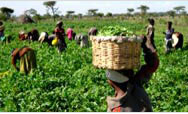Over the last decade, 14% of Ugandan children have lost one or both parents due to the on-going conflict in northern Uganda or the high prevalence of HIV/AIDS. USAID has provided assistance to these vulnerable children and adolescents through indigenous community-based and faith-based organizations. These organizations are implementing activities that provide care and support, reduce stigma and discrimination, increase self-reliance, and teach practical skills.
One such organization, The AIDS Support Organization, runs an apprenticeship program targeting vulnerable adolescents who have little or no education. Adolescents choose to learn about motor vehicle mechanics, carpentry, hairdressing, cookery, sewing, or brick-laying. All the young people who graduate are given start up tool-kits to be used in their respective vocations.
After acquiring these vocational skills, the adolescents are more confident, have developed a sense of purpose, and can begin planning for their future. Of the adolescents who have entered the program, 92% have completed training and are now employed, providing for their families and for themselves.
|


